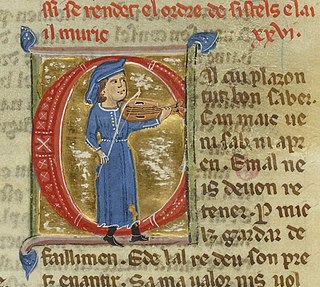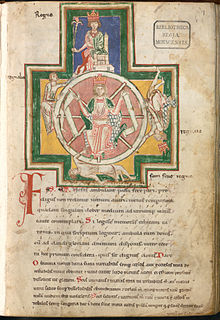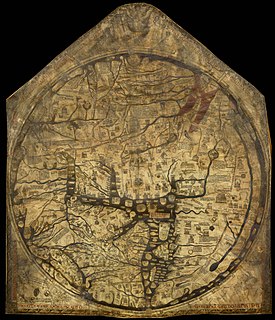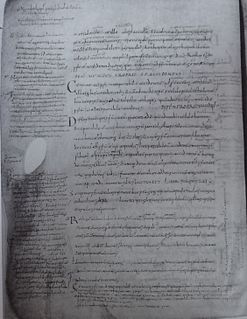
Marie de France was a poet, possibly born in what is now France, who lived in England during the late 12th century. She lived and wrote at an unknown court, but she and her work were almost certainly known at the royal court of King Henry II of England. Virtually nothing is known of her life; both her given name and its geographical specification come from her manuscripts. However, one written description of her work and popularity from her own era still exists. She is considered by scholars to be the first woman known to write francophone verse.

A troubadour was a composer and performer of Old Occitan lyric poetry during the High Middle Ages (1100–1350). Since the word troubadour is etymologically masculine, a female troubadour is usually called a trobairitz.

Carmina Burana is a manuscript of 254 poems and dramatic texts mostly from the 11th or 12th century, although some are from the 13th century. The pieces are mostly bawdy, irreverent, and satirical. They were written principally in Medieval Latin, a few in Middle High German and old Arpitan. Some are macaronic, a mixture of Latin and German or French vernacular.
Bartholomaeus Anglicus, also known as Bartholomew the Englishman and Berthelet, was an early 13th-century scholastic of Paris, a member of the Franciscan order. He was the author of the compendium De proprietatibus rerum, dated c.1240, an early forerunner of the encyclopedia and a widely cited book in the Middle Ages. Bartholomew also held senior positions within the church and was appointed Bishop of Łuków in what is now Poland, although he was not consecrated to that position.

The goliards were a group of, generally young, clergy in Europe who wrote satirical Latin poetry in the 12th and 13th centuries of the Middle Ages. They were chiefly clerics who served at or had studied at the universities of France, Germany, Spain, Italy, and England, who protested against the growing contradictions within the church through song, poetry and performance. Disaffected and not called to the religious life, they often presented such protests within a structured setting associated with carnival, such as the Feast of Fools, or church liturgy.

Medieval literature is a broad subject, encompassing essentially all written works available in Europe and beyond during the Middle Ages. The literature of this time was composed of religious writings as well as secular works. Just as in modern literature, it is a complex and rich field of study, from the utterly sacred to the exuberantly profane, touching all points in-between. Works of literature are often grouped by place of origin, language, and genre.

A mappa mundi is any medieval European map of the world. Such maps range in size and complexity from simple schematic maps 25 millimetres or less across to elaborate wall maps, the largest of which to survive to modern times, the Ebstorf map, was around 3.5 m in diameter. The term derives from the Medieval Latin words mappa and mundus (world).
Cursor Mundi (Latin), translated as Runner of the World, is a Middle-English historical and religious poem of nearly 30,000 lines written around A.D. 1300 by an unknown author.

The Hereford Mappa Mundi is a medieval map of the known world, of a form deriving from the T and O pattern, dating from c. 1300. It is displayed at Hereford Cathedral in Hereford, England. It is the largest medieval map still known to exist. A larger mappa mundi, the Ebstorf map, was destroyed by Allied bombing in 1943, though photographs of it survive.
Virgilius Maro Grammaticus is the author of two early medieval grammatical texts known as the Epitomae and the Epistolae.
Bernard of Cluny was a twelfth-century French Benedictine monk, best known as the author of De contemptu mundi, a long verse satire in Latin.
De Contemptu Mundi is the most well-known work of Bernard of Cluny. It is a 3,000 verse poem of stinging satire directed against the secular and religious failings he observed in the world around him. He spares no one; priests, nuns, bishops, monks, and even Rome itself are mercilessly scourged for their shortcomings. For this reason it was first printed by Matthias Flacius in Varia poemata de corrupto ecclesiae statu as one of his testes veritatis, or witnesses of the deep-seated corruption of medieval society and of the Church, and was often reprinted by Protestants in the course of the seventeenth and eighteenth centuries.

Medieval French literature is, for the purpose of this article, Medieval literature written in Oïl languages during the period from the eleventh century to the end of the fifteenth century.
The earliest known world maps date to classical antiquity, the oldest examples of the 6th to 5th centuries BCE still based on the flat Earth paradigm. World maps assuming a spherical Earth first appear in the Hellenistic period. The developments of Greek geography during this time, notably by Eratosthenes and Posidonius culminated in the Roman era, with Ptolemy's world map, which would remain authoritative throughout the Middle Ages.
"O Fortuna" is a medieval Latin Goliardic poem which is part of the collection known as the Carmina Burana, written early in the 13th century. It is a complaint about Fortuna, the inexorable fate that rules both gods and mortals in Roman and Greek mythology.
Philippe le Chancelier, also known as "Philippus Cancellarius Parisiensis" was a French theologian, Latin lyric poet, and possibly a composer as well. He was the illegitimate son of Philippe, Archdeacon of Paris, and was part of a family of powerful clerics. He was born and studied theology in Paris. He was chancellor of Notre Dame de Paris starting in 1217 until his death, and was also Archdeacon of Noyon. Philip is portrayed as an enemy to the Mendicant orders becoming prevalent at the time, but this has been greatly exaggerated. He may have even joined the Franciscan order soon before his death.
Vita Merlini, or The Life of Merlin, is a Latin poem in 1,529 hexameter lines written around the year 1150. Though doubts have in the past been raised about its authorship it is now widely believed to be by Geoffrey of Monmouth. It tells the story of Merlin's madness, his life as a wild man of the woods, and his prophecies and conversations with his sister, Ganieda, and the poet Taliesin. Its plot derives from previous Celtic legends of the bard Myrddin Wyllt and the wild man Lailoken, and it includes an important early account of King Arthur's final journey to Avalon, but it also displays much pseudo-scientific learning drawn from earlier scholarly Latin authors. Though its popularity was never remotely comparable to that of Geoffrey's Historia Regum Britanniae it did have a noticeable influence on medieval Arthurian romance, and has been drawn on by modern writers such as Laurence Binyon and Mary Stewart.
Oxford, Bodleian Library, Rawlinson B 502 is a medieval Irish manuscript which presently resides in the Bodleian Library, Oxford. It ranks as one of the three major surviving Irish manuscripts to have been produced in pre-Norman Ireland, the two other works being the Lebor na hUidre and the Book of Leinster. Some scholars have also called it the Book of Glendalough, in Irish Lebar Glinne Dá Locha, after several allusions in medieval and early modern sources to a manuscript of that name. However, there is currently no agreement as to whether Rawlinson B 502, more precisely its second part, is to be identified as the manuscript referred to by that title.
Reginald of Canterbury was a medieval French writer and Benedictine monk who lived and wrote in England in the very early part of the 12th century. He was the author of a number of Latin poems, including an epic entitled Malchus, which still survives.

Israel the Grammarian was one of the leading European scholars of the mid-tenth century. In the 930s, he was at the court of King Æthelstan of England (r. 924–39). After Æthelstan's death, Israel successfully sought the patronage of Archbishop Rotbert of Trier and became tutor to Bruno, later the Archbishop of Cologne. In the late 940s Israel is recorded as a bishop, and at the end of his life he was a monk at the Benedictine monastery of Saint-Maximin in Trier.






